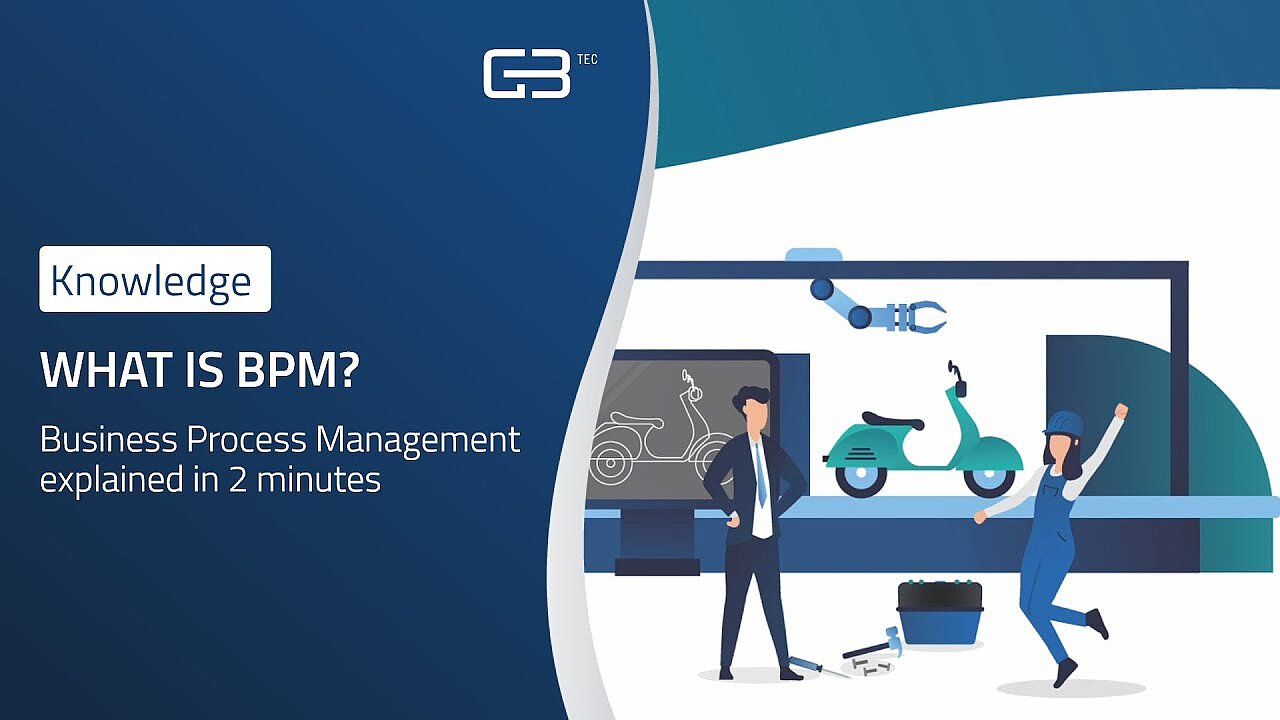BIC Process Design
Understand & Transform
Supercharge your business operations with the most intuitive AI-powered BPM software.
It seems that you come from a German speaking country. Here you can change the language
EnglishBusiness processes are the heart of any organization. Only if they run smoothly, a company can be successful in the long term and keep its resolutions. Business Process Management is the elementary basis for continuously optimizing processes and leading companies into full automation and digitalization.

Business process management is a method for designing, executing, analyzing and continuously improving the processes in an organization in a goal-oriented manner. Graphical notations such as the event-driven process chain (EPC) or Business Process Model and Notation (BPMN) can be used to graphically depict the processes in the company in a clear manner, which forms a basis for professional business process management. The uniform modeling language BPMN 2.0 is currently a widely used standard for business process modeling. The central question, "Who does what, when and with what tools?" can be easily answered with BPM because it includes all areas of an organization in the analysis, from employees to systems to customers, suppliers and partners. With BPM, all processes can thus be defined and various business processes can be reflected transparently. The goal of this concept is to use all information about the company's processes and align them with the achievement of business goals. Only those who know their existing processes from start to finish and how they work, can optimize them, adapt them to customer needs and, as a result, achieve their business goals more quickly and efficiently. Since the processes and goals in the company change continuously, business process management should be viewed less as a one-time project and more as a continuous activity for process improvement.

The company's own business processes form the core of every organization. They must function optimally so that defined goals are met and companies can set themselves apart from their competitors in the long term. A BPM solution as the basis for digital transformation is the key to success: With a digital view of the entire business, companies continuously review and improve their structures and processes, identify new potential and business areas, and can use the information gained to align their offerings with the needs of their customers. In this way, they achieve complete transparency in all operations, increase the speed of the process flow and strengthen their flexibility through automation. This improved understanding and continuous optimization and automation of processes significantly reduces errors and waste and saves time. New challenges and market trends in the industry can be mastered in a structured manner with a BPM system and established as new business models. Business Process Management represents the elementary foundation for higher productivity and efficiency in the company and is consequently indispensable in order to keep up with the times and remain successful in the market in the long term.
The various BPM activities can be represented in a control loop, which is a central component of process management. It provides a detailed insight into the process landscape and uncovers optimization potential. Since companies act dynamically and continuously realign their own business processes and goals in order to optimize them, the individual phases of the entire BPM lifecycle run iteratively.

1. Design
In a first step, the already existing processes are analyzed. In addition, certain goals are defined that are supposed to be achieved as a result of business process management (BPM).
2. Modeling
In the modeling phase, the company selects new processes in order to describe them individually according to its own requirements and to define target processes on this basis.
3. Execution
The modeled business processes are recorded and documented. Afterwards, they are implemented in a process model, published in the internal IT system and executed.
4. Monitoring
In this phase, the processes are continuously monitored and analyzed. A data-based comparison of the actual processes with the modeled target specifications reveals optimization potential. Only those who have a precise knowledge of the potentials and critical points of their processes can derive solutions as well as exact measures and implement them efficiently.
5. Optimization
Based on the insights gained, improvement measures are then carried out on the processes and the target definitions implemented. With classic process optimization concepts such as Kaizen or Six Sigma, the main aim is to monitor and continuously improve throughput times, cost efficiency, error rates and other key performance indicators, for example by automating or linking processes.
With the adjustments to the processes, a new design phase begins - the BPM lifecycle closes and the control loop starts again. Only if the processes run through this control loop completely and all phases of the entire life cycle are taken into account, it is possible to measure progress and continuously improve the individual processes.
Thanks to the systematic approach of digital business process management and the idea of continuous improvement, companies benefit from a more efficient organization as well as numerous other advantages.

Automation and optimization of business processes
Smoothly running processes significantly increase the quality of performance in operations. With automated processes, the cycle times of individual process steps are reduced and the need for insights and controls is minimized, saving companies valuable time every day.

Transparent and consistently documented end-to-end business processes
All business processes are clearly documented in a central management software so that it is clear at all times how the processes run and who is currently working on which task. This transparency in the end-to-end processes makes it possible to identify optimization and automation potential at an early stage and implement it in a meaningful way.

Efficient workflow management and system combinations
With BPM, companies design, test, implement and establish interactions between people, data and systems - in a no-code or low-code BPM suite even as non-IT experts. They can set up business workflows to facilitate process execution and combine different systems.

Continuous monitoring and data-based
analysis
Continuous monitoring and visualization of workflows in real time is a prerequisite for subsequent optimization. The data obtained enables, for example, a target/actual comparison, establishes average values and reveals possible deviations.

Shift to an agile and process-oriented organization
With the help of the BPM practice, companies focus on their own processes and anchor them comprehensively in their own operations. In this way, processes can be systematically aligned with the requirements of customers as well as the goals of the organization and make a significant contribution to success.

More transparency thanks to reduced system and process complexity
If previously manual process steps are restructured and digitalized with BPM, the number of people involved is usually reduced as well, so that there are fewer interfaces in the process. This not only minimizes the complexity of the process landscape, but also leads to greater stability and transparency.
In addition to pure process modeling, professional BPM software incorporating best-of-breed technologies such as RPA, artificial intelligence and process mining is also an elementary basis for comprehensive business process automation, which is a central component of the digital transition. Process mining technologies, for example, identify automation and optimization potential at an early stage, as they enable objective transparency through tool-based process analyses. Robotic Process Automation (RPA) can be used to automate workflows by having so-called software robots take over repetitive tasks. In RPA tools, structured content can be created for this purpose and software bots can be configured to process transactions and communicate with other digital systems.
The use of these new technologies results in major competitive advantages such as higher process speed, cost savings, increased process quality and more effective employee utilization. However, to ensure that organizations do not automate meaningless processes, the process model should be viewed in a holistic approach in which process-specific automation solutions are implemented instead of individual isolated bots.
Discover our full-scope BPM suite BIC Platform and benefit from the numerous advantages of professional business process management software. Whether process modeling, execution, measurement or optimization: With our powerful modules BIC Process Design, BIC Process Execution, BIC Process Mining and BIC GRC Solutions you get the best out of your processes and drive the digital change in your company. All tools can be individually combined with each other, so that your requirements are covered precisely and you achieve your business goals efficiently. BIC also stands for the most advanced technology, modern design and high usability - find out for yourself.
Those who face up to the challenges of the digital transition and perceive change as an opportunity, are setting the course for a successful future. An innovative BPM solution forms the fundamental basis for companies to master their business strategy and transformation. Existing business processes are optimized and, if possible, automated, and new business models can be successfully established holistically along cross-functional processes.
However, changes in IT and business processes as a result of the digital transformation are continuously placing new demands on process management. Holistic change is therefore more important than ever for companies to sustainably increase their efficiency as well as quality and achieve target-oriented standardization.
In the long term, the use of business process management means that companies can manage increasing process complexity more easily, make flexible adjustments more quickly, and offer an enhanced customer experience due to better products and services based on data-driven information. Goal and benefit: To stand out from the competition and be successful on the market in the long term.

CEO
Gregor, founder of GBTEC, is a leading expert in Business Process and IT Transformation. For over 20 years, he has been a key figure shaping the BPM world. His passion for designing efficient processes emerged during his studies in business informatics. As the mastermind behind the BIC Platform, Gregor and the GBTEC team develop a comprehensive software suite that covers the entire transformation cycle — from intelligent Business Process Management (iBPM) and Enterprise Architecture Management (EAM) to Digital Process Automation (DPA), Process Mining and Governance, Risk and Compliance (GRC).
We have the information you need to unleash your full process potential. Take a look at our resources and start improving your business performance today.